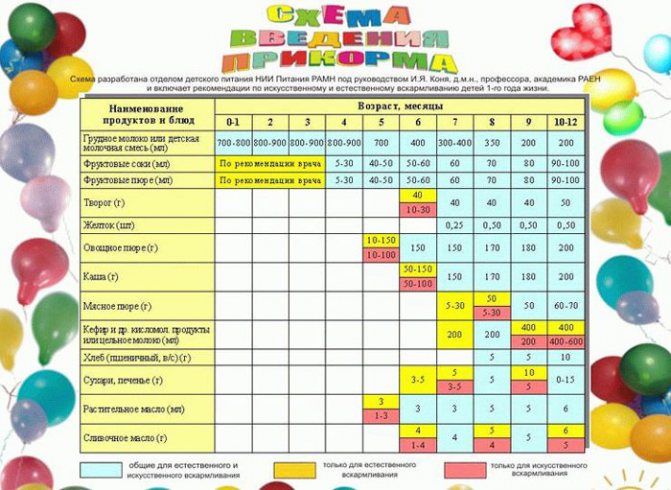Pediatricians, WHO specialists and lactation consultants recommend feeding a child with breast milk until two or three years of age, provided that lactation continues and mother and baby feel comfortable. Such nutrition performs useful functions, provides vitamins and elements necessary for the full growth and development of the child. Let's take a closer look at whether breast milk is beneficial after a year. Let's learn how to organize breastfeeding for a child older than one year.
Composition and properties of breast milk after a year of feeding
After a year, more immunoglobulins appear in milk, which are aimed at strengthening the immune system and protecting the child from various diseases. It has been proven that infants aged 1.5-2.5 years get sick less often than babies who do not receive breast milk. In addition, such children recover faster and tolerate illness more easily.
Breast milk is a valuable source of protein and fats, vitamins and minerals. After one year, the child receives up to 500 ml of breast milk per day. This volume covers the following needs of the child after one year:
| Vitamin A – up to 75% |
| Vitamin B3 – up to 40% |
| Vitamin B12 – up to 94% |
| Vitamin C – up to 60% |
| Iron – 5% |
| Zinc – 16% |
| Calcium – 36% |
| Fats – up to 62% |
| Carbohydrates – up to 22% |
| Protein – up to 43% |
| Energy – up to 32% |
Breastfeeding is especially important for children with allergies or prone to allergic reactions. Such nutrition alleviates allergic conditions and forms a protective film in the intestines that prevents allergens from entering the blood. In addition, prolonged feeding promotes proper bite formation and reduces pain during teething. Thus, we see that the benefits of breast milk after a year remain as invaluable as for children in the first 6-12 months.
Benefits for baby's health
Nutritional benefits:
- Every year, mother's milk becomes more valuable and healthier, but this does not mean that you need to feed your child until he is five years old.
- The fat content of milk also increases due to the amount of protein produced. Although many say that the milk becomes more liquid. This is a myth and should not be believed.
- Infants who are breastfeeding have low weight. Of course, this can be, because the baby does not eat formula, from which he is rapidly recovering. Breastfed babies are more active and waste their energy, which may prevent them from gaining weight. In fact, this is not bad, because the child weighs as much as he needs, does not suffer from hunger and behaves actively. Modern pediatricians are accustomed to adjusting children to the criteria of long-developed curves, and if the baby does not meet it, then they prescribe mixtures. Therefore, before introducing it into your child’s diet, remember that breastfeeding reduces the risk of obesity in children.
- The level of immunoglobulin (A) increases.
- Substances are formed that stimulate the baby’s immunity.
- Fatty acids contained in mother's milk, when entering the baby's body, destroy harmful bacteria.
- Oligosaccharides nourish the child’s gastrointestinal flora.
- The concentration of lysozyme and lactoferrin increases, which also helps to destroy “bad” bacteria.
- Thanks to breastfeeding, the maxillofacial apparatus develops and the problem of malocclusion is reduced.
- Thanks to breast milk, stem cells enter the baby's body.
Growth and Development:
Immunity and overall health:
The importance of breastfeeding for an older child is difficult to overestimate, because thanks to it the baby feels calm, he believes that he is protected from everything. This is the perfect way to put your baby to sleep or calm him down. Sometimes this saves time and brings peace of mind to the whole family.
Breastfeeding itself makes up the bulk of a child’s diet in order to provide his body with valuable vitamins and microelements. And close contact with the mother during this process will only strengthen the connection; she is the child’s guide to the world around him.
Breastfeeding children over one year old plays an important role in the family’s night life, especially in those moments when you wean your baby from sleeping with you or gradually transfer him to natural food by introducing complementary foods.
The benefits of breastfeeding after a year for a child
- Supports and enhances immunity, reliably protects against viruses. Infants are less likely to catch colds, tolerate illnesses more easily and recover quickly;
- Improves digestion, improves the absorption and digestion of complementary foods, prevents intestinal colic and stomach upsets;
- Positively affects the development of mental abilities. Infants develop faster and adapt more easily to society;
- Ensures the health of the baby's oral cavity, prevents the formation of malocclusion and reduces the risk of caries, relieves pain during teething;
- Develops the speech apparatus. Infants who receive milk for a long time begin to speak faster and earlier;
- Creates a comfortable psychological environment. The child grows up calmer, psychologically stable and confident. He is not capricious and less susceptible to stress;
- Relieves allergic conditions and protects against allergic reactions;
- Provides a close connection between baby and mother.
The benefits of breastfeeding after a year for mothers
- Restores the reproductive system after childbirth;
- Replenishes and accumulates vitamins and beneficial elements that were lost during pregnancy and childbirth;
- Reduces weight as milk production burns a large number of calories;
- Effective prevention of osteoporosis. It has been proven that the risk of developing this disease in old age decreases by 20% with each child fed;
- Reduces the risk of cancer by 55%, including breast and ovarian cancer;
- Restores breast shape and prevents sagging. For more information on how to restore breast shape to a nursing mother, read the article “How to restore breasts after feeding”;
- Provides a close connection between baby and mother.
Disadvantages of breastfeeding after one year
- Emotional and physical fatigue, moral exhaustion;
- Lack of time for sleep and rest;
- It is important to constantly monitor your diet and stick to your diet when breastfeeding, giving up your favorite foods;
- Inability to leave a child without a mother for several days;
- A woman cannot devote more time to herself and other family members;
- A nursing mother cannot fully go to work and be away from her baby for a long time;
- Painful sensations in the mammary glands, the risk of lactostasis and mastitis. It is important to properly care for your breasts and nipples during breastfeeding;
- Painful sensations, cracks and abrasions on the nipples, including if the child bites the breast.

Myths about long-term feeding
Many are convinced that after a year, breast milk loses its value and fat content, becomes like water, has no beneficial effect, or even causes harm to the baby. However, it is not. The composition of breast milk constantly changes and adapts to the age of the baby and the body's requirements at a certain period. And the fat content of breast milk after a year of breastfeeding, on the contrary, increases two to three times. At the same time, it is easily digestible.
Often, women during lactation experience severe hair loss, deterioration of teeth and skin. However, such problems are not associated with breastfeeding, but with the restructuring of the body and restoration of hormonal levels after childbirth. As practice shows, over time, even with prolonged feeding, a woman’s health and appearance are restored and even improved. Read here what to do if your hair falls out a lot while breastfeeding.
Another myth is that when breastfeeding for a long time, children become capricious and become strongly attached to their mother. But this is not true either. Breastfeeding establishes a close and trusting bond between mother and baby, the child grows up confident and calm. On the contrary, if a woman does not breastfeed and pay due attention to the baby, the child will grow up nervous and restless, deprived of affection and care, which negatively affects mental and emotional development.

Cultural Expectations
In many parts of the world, children are breastfed until they are 2-4 years old.
On the other hand, the surprise is that in some countries only about 25% of mothers breastfeed after one year. This is definitely due to a lack of support, reduced maternity leave, a lack of flexible working hours that allow for breastfeeding or pumping, or simply due to cultural expectations (that a mother should wean her baby after a year).
Pumping milk full time isn't easy. The cultural expectation that babies should be weaned within a year is also very ingrained. There's no real reason for this other than anticipation, as bottle serving has really been encouraged for the last few generations. Some people perceive breasts as a sexual object rather than as a body part for feeding a baby, so it seems strange and disturbing to see a baby being placed on the breast.
This, however, is definitely their problem, not yours! Therefore, do not pay attention to these people and do not engage in meaningless arguments with them!
Breastfeeding after 1 year is a huge achievement and something to brag about. There is more and more talk about the benefits of breastfeeding, and mothers are being informed and encouraged by breastfeeding associations to continue it.
Rules for breastfeeding after one year
- After a year, the number of feedings is three to four times during the day and once or twice at night;
- At two to three years of age, feeding continues once or twice at night and during the day;
- The main feedings occur “around sleep”, i.e. before the baby falls asleep and immediately after waking up;
- Breastfeeding for a child after a year becomes auxiliary, and the main thing is complementary feeding and receiving adult food;
- Introduce new foods into complementary foods, prepare your baby’s favorite dishes more often;
- Gradually reduce the duration of applications;
- Replace unnecessary daily attachments with games and exciting activities, walks, exercises and massage. After a year, a child’s routine should become more varied;
- First, remove unnecessary and unnecessary breastfeeding during the day. Then remove daytime feedings “around sleep”;
- Feedings are removed last at night, before bedtime and upon awakening. As a rule, weaning off night feedings is the hardest thing to do.

Complementary feeding - when and how much is needed?
Let us immediately note that complementary feeding means natural nutrition, and not all kinds of jars and mixtures. In fact, this is the food that your family eats, with the exception of fast food, fatty and spicy foods, sausages, sweets and others. The main rule is that food should be simple and healthy.

If you feed your child regular food from your table, you will help form eating habits, get used to family traditions, rules, and introduce snacks into the diet. At this stage, your task will be to teach your child to eat and not play with food.
. You should immediately remove your child from the table if he begins to act up or throw food. He must "earn" the food by his good behavior. You should not throw away food in front of your child, because otherwise he will start thinking the same way.
It is important to follow portions of complementary foods and not stop breastfeeding at this time. A pinch of one product is enough, and gradually you need to increase it. Little by little, you can introduce exotic fruits into your child’s diet to develop his food interest. Whenever possible, go with your baby to a cafe or visit friends to introduce new foods to his diet and learn to accept different foods, not just homemade ones.
You should feed your baby with a spoon; you can buy a small size especially for him. The same goes for the bowl. The child should know that he has his own dishes and should eat from them. It is also important that the child eats with you, and not separately before or after mom and dad eat.
But if you decide not to follow these rules
and still stop breastfeeding your child after two years, you should know:
Having considered all the pros and cons, we move on to the main topic, namely the organization of breastfeeding after a year.
When is the best time to stop breastfeeding?
Breastfeeding should be fully present in the life of every child until at least six months. After six months, the first complementary foods are introduced, so the number and duration of feedings are gradually reduced. Some pediatricians are inclined to believe that feeding should be stopped after a year. But, as we have already found out, breast milk is also very useful for children aged 1-3 years. Therefore, if lactation is still ongoing, and feeding does not cause discomfort for the mother, breastfeeding can be continued for up to three years.
It is not advisable to stop breastfeeding during teething, epidemics of infectious diseases or when the child is sick, because breast milk strengthens the immune system and helps to recover faster. Don't stop breastfeeding when your baby is stressed. This can be observed upon admission to a nursery, prolonged separation from mother, or when moving.
Weaning will only increase stress and worsen the child's psychological state. It is not recommended to stop feeding in extreme heat, as breast milk satisfies thirst as much as possible and normalizes the water balance in the baby’s body.
The main rule for completing lactation is that this should be done smoothly and gradually.
When finishing breastfeeding, do not wrap your breasts with bandages, sheets or towels! Do not apply mustard or other similar products to your nipples or breasts. This can be very frightening, burn your child's mouth, or cause an allergic reaction. How to competently and correctly complete breastfeeding, see the link https://vskormi.ru/breast-feeding/kak-otuchit-rebenka-ot-grudnogo-vskarmlivanija/. Subscribe to our VKontakte group
Breastfeeding after one year
In modern society, expectant mothers often prepare in advance for breastfeeding, want to feed their babies and understand the importance of prolonged breastfeeding. Often, having overcome difficulties at the beginning of feeding, a mother plans to feed for a long time.
However, in reality, a woman breastfeeding an older child may feel insecure and doubt whether she made the right choice. Usually mothers hear:
- So big and still sucking!
- It's a shame, it's time to wind down!
- Is she going to suck you off until school?
- There’s nothing in your milk anymore...
In this article we will try to dispel myths about feeding older children and tell you what natural feeding looks like after a year.
Often, mothers’ desire to wean their baby from the breast at a non-physiological time (up to 1.5 years) is associated with improper organization of breastfeeding; these are precisely educational moments. If a child literally does not give way, strives to latch onto the breast at every opportunity, reaches under clothes, loudly demands the breast in an “inconvenient” place, and at night even “hangs” on the mother - this is a reason to reconsider the relationship between mother and baby. In fact, everything should be quite the opposite.
In organizing breastfeeding after one year, the leading role of the mother and her ability to build a harmonious relationship with the baby is very important. That is, the mother sets the rules of behavior; the mother knows how to negotiate with the baby; The mother decides when and where to breastfeed her baby. With an older child, you can begin to discuss feeding times, starting with a request to wait a minute, then gradually increasing the time you wait to attach to the breast. It’s good if a special place is allocated for feeding (say, it will be a chair, a sofa or a certain area in the apartment) and breastfeeding will take place only there. It is possible and necessary to limit breastfeeding if it is inconvenient for the mother to breastfeed now (for example, in a store, in transport).
By one year, the child is already quite ready physiologically and psychologically to stay with grandmothers and other relatives/confidants, so it is very important for the mother to practice leaving home. First of all, this will have a positive effect on the mother’s mental health. It has been noticed that if the mother is not mentally tired by the first year of the child’s life, breastfeeding after a year brings joy. Secondly, the child will learn to build relationships with other adults and, of course, this will only have a positive effect on the relationship with the breast. After all, another point because of which mothers strive to wean their older children is that the child refuses to eat regular food or eats very reluctantly. This happens when the mother is completely inseparable from the child, and the breast is always freely available.
It is very important to understand that breastfeeding after a year is not only and not so much nutrition, but also the relationship between mother and child, educational moments and moments of pleasant togetherness, a break from mother’s affairs. A close connection with the mother helps the baby grow up more open and friendly to the world, more self-confident, which then helps him in adulthood.
Separately, I would like to draw attention to the exhausting night feedings. Perhaps this is one of the most common reasons why a mother wants to wean her child. You need to understand that night freezes are an indicator of some existing problems. Think about whether you devote enough time to your child during the day, play with him, hug him, and are you absent too often and for a long time? Usually, with continuous night sucking, the baby compensates for the lack of mother’s attention during the day.
Myths about long-term breastfeeding [1, 2].
Myth No. 1: After a year there is nothing in milk, it is useless.
Fact: Perhaps one of the most common arguments about the optionality of guarding after a year sounds exactly like this. However, scientific research suggests otherwise. The fat content of human milk increases 2-3 times after a year of breastfeeding [3]. The amount of immunoglobulins and antibodies increases [4]. It has been noted that the later cow’s milk and other common allergens enter a child’s diet, the less likely it is to develop allergic reactions [5]. Thus, the immunity of long-term feeding babies is stronger.
Myth No. 2: Prolonged breastfeeding destroys a woman’s health, in particular, it flushes calcium from the body.
Fact: The content of calcium and phosphorus in lactating women is higher than in non-breastfeeding women (lactation stimulates the absorption of calcium and a special form of vitamin D, which helps to absorb and accumulate it in the body) [6, 7]. Women are less at risk of osteoporosis in old age [8]. It is also appropriate to mention here that long-term breastfeeding is beneficial for the health of the breasts and female reproductive organs (uterus and ovaries) [9]
Myth #3: Long-term feeding has a negative impact on the mental health of children, especially boys.
Fact: There are no scientific studies confirming the harm of long-term guarding for either boys or girls. But there is data confirming a higher level of social adaptation, a decrease in the frequency of problem behavior, the ability to build harmonious relationships with a partner when starting a family, etc. [10].
- Kneidel S. Nursing Beyond One Year. Original article: https://www.lalecheleague.org/nb/nbjulaug90p99.html
- Dermer A. A Well-Kept Secret Breastfeeding's Benefits to Mothers. Original article: https://www.llli.org/nb/nbjulaug01p124.html
- , C.G. et al. Is prolonged breastfeeding associated with malnutrition? Am J Clin Nutr 1984; 39:307-14. (https://www.llli.org/russian/nb/toddler.html)
- , A.S. et al. Immunologic components in human milk during the second year of lactation. Acta F'aediatr Scand 1983; 722:133-34. (https://www.llli.org/russian/nb/toddler.html)
- Savilahti, V. M. et al. Prolonged exclusive breast feeding and heredity as determinants in infantile atopy. Arch Dis Child 1987; 62 269-73. (https://www.llli.org/russian/nb/toddler.html)
- Lawrence, R., Lawrence, R. Breastfeeding: A Guide for the Medical Profession. St. Louis: Mosby, 1999. (https://www.llli.org/russian/subject/importance/mother/benefits.html)
- Sowers, M., Randolph, J., Shapiro, S. Jannausch, MA prospective study of bone density and pregnancy after an extended period of lactation with bone loss. Ostet Gynecol 1995; 85:285. (https://www.llli.org/russian/subject/importance/mother/benefits.html)
- Gottlieb Z. Duration breast-feeding linked to osteoporosis risk https://www.reuters.com/article/us-breast-feeding-idUSTRE69O4LL20101025
- Ing, K, Ho, J., Petrakis, N. Unilateral breastfeeding and breast cancer. Lancet 1977; 2: 124. (https://www.llli.org/russian/subject/importance/mother/benefits.html)
- Ferguson, D. M. et al. Breastfeeding and subsequent social adjustment in six- to eight-year-old children. J Child Psychol Psychiatr Allied Discip 1987; 28:378-86 (https://www.llli.org/russian/nb/toddler.html)
If you still have any questions after reading this article, or there are any difficulties in continuing breastfeeding after a year, you can always ask them in our support group in the appropriate topic or chat with our consultants directly so that long-term breastfeeding brings you With the baby there is only joy and health!
Daria Feldsherova, Asya Shchegol, lactation consultants (edited by Polina Novoselova, lactation consultant)











